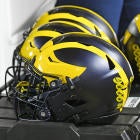DENVER -- The smaller conferences failed to reach equal footing with the power groups, which was expected, but are still getting a significant bump in pay and an access point to the six-bowl, four-team playoff that BCS presidents approved on Monday.
They got creative with the seventh-playoff-bowl concept in partnership with the Big 12 and the Pac-12. That idea collapsed, in part, because of revenue projections. How much more would the game be worth than the Liberty Bowl, which is Conference USA vs. SEC No. 8 and corrals roughly $1 million in TV rights each year? Even the Cotton Bowl, which is the SEC No. 2 vs. the Big 12, is only $2.2 million.
| More on college football |
| Related links |
|
| More college football coverage |
That's why it was worth the Group of Five (Big East, MAC, Mountain West, Conference USA and Sun Belt) to get one of the 12 access points for its highest-ranked team -- especially for the Big East, which, including incoming member Boise State, would have qualified in seven of the last nine years under the new model.
As Big East senior associate commissioner Nick Carparelli pointed out on Monday, "It wasn't about a seventh bowl. It was about a guaranteed spot."
"We’ll be in a bowl on either New Year’s Eve or New Year’s Day," Big East commissioner Mike Aresco said. "We expect our champion to compete every year for that slot. Based on history, it’s a good position to be in.”
The presidents probably wouldn't have approved a playoff model that completely shut out the Group of Five, so the Group was well positioned here despite taking a growing but still-small percentage of the revenue pot. They were never going to get Big 12 or SEC money, or even anything close.
A source with knowledge of the discussions told CBSSports.com that the Group of Five anticiaptes a collective revenue share of at least 20 percent, up from 15 percent under the BCS model. The looming playoff television deal has been estimated at close to $500 million per year. And teams that enter the top-four playoff get even bigger payouts than the other access points.
"They have unanimously approved this deal, and they did it with smiles on their faces." said Nebraska Chancellor Harvey Perlman. "I think they thought it was fair. And it is fair. Those that made the investments that produced the revenue ought to get a good share of the revenue. I think [the smaller conferences] always acknowleged that. They will get significantly more than they got."
No argument from Northern Illinois President John G. Peters, a BCS oversight committee member who had a simple goal: "If we competed on the field, we could have access to a bowl."
The playoff format is convoluted. Explaining it can be difficult. But in its simplest form: Teams can vie for four playoff spots, which leads to a stand-alone national championship game, and the other eight guaranteed access points are just really expensive bowl games -- sort of like the BCS.
Those games are either contract bowls (the SEC vs. Big 12 Sugar Bowl, the Pac-12 vs. Big Ten Rose Bowl, the ACC vs. SEC/Big Ten/Notre Dame) or "host" bowls. The Chick-Fil-A, Cotton, Fiesta or Capital One bowls are prime candidates for those host bowls. All six of the bowls will rotate into the semifinals over a 12-year span.
The contract bowls are worth so much -- up to $80 million per year for Sugar and Rose -- that the confusing nature of the access system becomes an afterthought for the committee.
The Group of Five can either crack the top four or land in a "host" game. Not a bad deal for the conferences, all things considered.




















